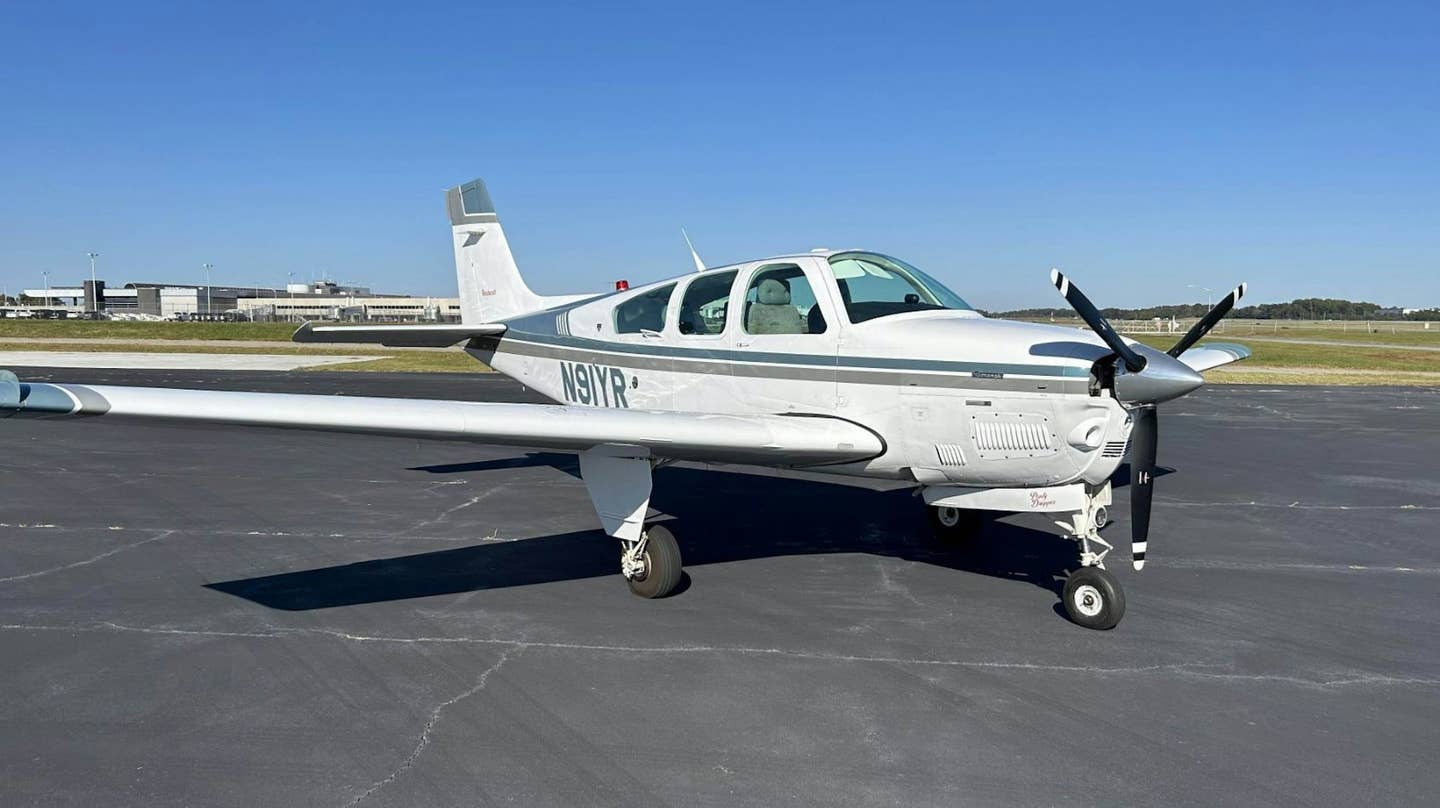
** The cowling of a recent Piper Saratoga has half
the inlet area of the old Cherokee 6’s, but makes
better use of it. (Top: Jose Jorge; Bottom: Phil Vabre)**
The cowling surrounding a reciprocating engine is a sophisticated aerial garbage disposal. Its job is to throw away about $1.50 out of every $6 you spend on avgas.
Gasoline contains more energy per pound than TNT, but engines turn only about a quarter of that energy into useful power. What happens to the rest? It dribbles off as waste heat, to be absorbed by the atmosphere. Half blows out the exhaust pipe; some of that, however, can be harvested and put to good use by a turbocharger. The remaining quarter heats up the engine and its accessories. If the engine were uncooled it would become very hot indeed; gases get up to 3,000 degrees Fahrenheit and more in the combustion chamber. Aluminum begins to lose strength at around 500 degrees, however, and so it's imperative to carry off the combustion heat to keep cylinder head temperatures at a safe level — preferably around 375 degrees. The job of the cowling is to dispose of that heat at the lowest possible cost in drag.
In the early days of aviation, the finned cylinders of air-cooled engines and the big radiators of liquid-cooled ones simply hung out in the wind. That's how the J-3 Cub did it, and countless radials as well. The drag penalty was horrible, but the airplanes were so slow that people seem to have been willing to look the other way rather than retch at the sight.
Designers understood, however, even well before the genesis of the Cub, that a streamlined duct with suitably sized inlet and outlet could greatly reduce the drag of a radiator or an engine. And that is what a modern cowling is: a duct.
A cowling admits only as much air as is required, and then makes sure that all of that air touches the hot parts of the engine. The space inside it is divided into two compartments or plenums, a "high pressure" plenum or "cold side" and a "low pressure" plenum or "hot side." Between the two is the engine. Baffles — guides and barriers of thin sheet metal between the cylinders and between the engine and the inner surfaces of the cowling — force all of the cooling air to flow where it's needed.
In principle, cold air coming into the inlets spreads out and slows down in one plenum — usually on top of the engine — where its velocity is converted into pressure. The elevated pressure in turn forces the air down through the comblike cylinder fins, where it temporarily speeds up, and into the other plenum, where it again slows down and spreads out before being vented overboard.
The prevalent arrangement, in which air moves downward through the engine, is called "downdraft"; a few airplanes, notably the later Aero Commanders, various Rutan-designed homebuilts and, less notably, my own Melmoth 2, have used updraft cooling, venting the air from the top of the nacelle or cowling. Although various reasons can be found for selecting one arrangement or the other, one forceful argument involves nothing more dignified than dirt. The cooling air inevitably carries with it some oil mist and general engine dreck. For singles and low-wing twins, you prefer the dirt and staining to be kept out of sight, and so vents at the bottom of the cowling are the natural choice (unless you have a better idea, as I thought I did).
The word plenum adds dignity to a very simple idea. A plenum is a settling chamber in which air comes to rest after entering at high velocity. In principle, the dynamic pressure of the incoming air becomes static pressure inside the plenum, just as air entering the Pitot tube raises the pressure inside the airspeed indicator. Unfortunately, this conversion entails losses, and they contribute to the aerodynamic drag of the cooling process.
The passage through which air enters a plenum is called a "diffuser." In order to convert velocity into pressure with a minimum of loss, a diffuser must expand quite gradually and must therefore be very long. There is not enough space in any cowling for a perfect diffuser or even a moderately good one, and so many cowlings, especially older ones, dispense with a diffuser altogether, admitting air through holes with short, sharp-edged inner lips. A certain amount of potential pressure recovery is sacrificed, but there is still plenty to force cooling air through the cylinder fins.
Cooling air is needed at more places than just the cylinders. Oil, passing through a radiator, carries off two-thirds as much heat as the cylinders do, much of it picked up from the undersides of the pistons. Accessories like magnetos and alternators, which in typical installations are located on the downstream — that is, hot — side of the baffles, may need blast tubes squirting air at them from the colder high-pressure side. On turbocharged airplanes, radiators — commonly called "intercoolers," though sticklers for proper usage prefer "aftercoolers" — may be used to carry off some of the heat that results from the turbocharger compressing the induction air.
It's difficult to design a single set of fixed inlets and outlets that allows enough air through to cool the engine on a slow climb on a hot day but does not overcool it while cruising at altitude. Instead, adjustable ramps — "cowl flaps" — on the outlets from the cowling are used to regulate the flow. Only as much air as can go out can come in, and so the lips of the air inlets are rounded to allow excess air to spill over them smoothly, like water over the rim of an overflowing jar, when the exit area is throttled down by closing the cowl flaps.
Writers discoursing upon engine cooling often state that it is responsible for "as much as [fill in any number] percent of the total drag of the airplane." I have seen numbers ranging from a low of 5 to a high of 35 percent. Naturally, the cleaner the airframe and the more powerful the engine, the greater the proportion of the total drag that will be due to cooling.
On the other hand, it has occasionally been claimed that cooling can produce negative drag. I recently had occasion to edit the Wikipedia article — any idiot can — on a skimpy 1920s radial-engine cowling called a Townend Ring to challenge the preposterous claim that it produced thrust. The same claim was made, more plausibly, for the cooling system of the P-51 Mustang. The idea is that, like the combustor of a jet engine, the hot radiator expands the cooling air, increasing its velocity through the outlet. Since the same mass goes out as comes in, an increase in exit velocity would result in a forward thrust. It's questionable, however, whether enough thrust can be generated, given the relatively small heat rise in the cooling air, to overcome the internal resistance of the duct and radiator. Disagreements about this point simmered for years after the war, and when I interviewed several veterans of Mustang development at North American 16 years ago some residual heat was still detectable.
In recent years, as a result of studies conducted by S.J. Miley of Mississippi State in the 1970s, there has been a great trend toward replacing D-shaped inlets crowding the spinner with widely separated round ones. These clean up flow considerably and take better advantage of the propeller slipstream. Like many other innovations, this one was first adopted by agile amateur builders, who came up with some cowlings with remarkably tiny air inlets. The California builder of a 225-knot RV-4, Dave Anders, manages to cool his souped-up Lyc 360 with 30 square inches of inlet area — less than half the expected amount. I don't know how he manages it, but it shows that there's still a lot of room for improvement in cowling design.
Get online content like this delivered straight to your inbox by signing up for our free enewsletter.

Sign-up for newsletters & special offers!
Get the latest FLYING stories & special offers delivered directly to your inbox






